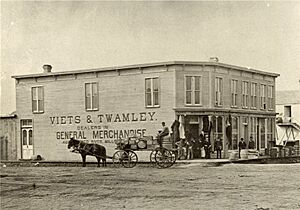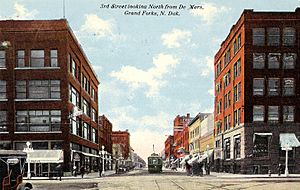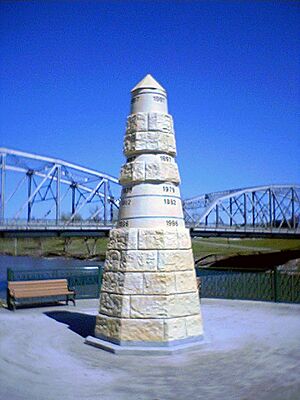History of Grand Forks, North Dakota facts for kids
The history of Grand Forks in North Dakota began with Native Americans and French fur trappers. They traded goods in the 19th century. Today, about 60 historic buildings and sites in Grand Forks are recognized on the National Register of Historic Places.
Contents
Early Days of Grand Forks
Grand Forks is the oldest major city in The Dakotas. Long before Europeans arrived, the area was a key meeting and trading spot for Native Americans. It was located where the Red River and Red Lake River meet.
French explorers and fur traders called this place "Les Grandes Fourches." This means "The Grand Forks." By the 1740s, it was an important meeting point for French fur traders. This trade continued until the French and Indian War. After this war, Canada became British.
In 1800, a British fur trader named Alexander Henry the younger set up a temporary camp here. By 1808, he had a permanent trading post. Other companies, like the Hudson's Bay Company and John Jacob Astor's American Fur Company, also had operations here by the 1820s.
In the mid-1800s, Les Grandes Fourches was a stop for Red River ox carts. These carts carried goods between St. Paul, Minnesota and Fort Garry (now Winnipeg, Manitoba). On June 15, 1870, the first post office opened. The name "Les Grandes Fourches" was changed to "Grand Forks."
Unlike many cities in North Dakota, Grand Forks did not start because of the railroad. It was first an important port for steamboats on the Red River. In late 1870, a steamboat captain named Alexander Griggs got stuck in the frozen Red River at Grand Forks. He and his crew had to stay there for the winter. They built a temporary shelter. Griggs decided this spot would be good for a town. In the spring, he claimed a piece of land that became downtown Grand Forks.
How Grand Forks Grew
A small town quickly grew. In 1875, The Plaindealer, the town's first newspaper, started. In 1879, George Winship started The Herald.
The cities of Grand Forks and East Grand Forks were first connected in 1879. Alexander Griggs built a floating toll bridge there. The city of Grand Forks officially became a city on February 22, 1881.
Grand Forks grew fast in its early years. Many immigrants and Americans from the east moved here. Steamboat traffic and the arrival of the railroad helped the growth. The St. Paul, Minneapolis, and Manitoba Railway (Great Northern Railway) reached Grand Forks in 1880. The Northern Pacific Railway came in 1887.
The first people to settle in Grand Forks were farmers and workers. But soon, merchants and professionals from Minneapolis also moved to the city. After the railroad arrived, old wooden buildings were replaced with brick ones. Large buildings like the Hotel Dacotah and the Security Building showed the city was growing.
In 1883, the University of North Dakota was founded by George H. Walsh. This happened before North Dakota became a state. In 1893, The Diamond Milling Company in Grand Forks started making a new breakfast cereal. They called it Cream of Wheat. By the early 1900s, Grand Forks was a major center for business, transportation, education, and health care in the region. It had many things usually found in bigger cities.
Grand Forks in the 20th Century
In the first half of the 20th century, Grand Forks kept growing. New neighborhoods appeared farther south and west of downtown. The 1920s saw the building of the state-owned North Dakota Mill and Elevator. This was on the north side of the city.
In 1954, Grand Forks was chosen for an Air Force base. Grand Forks Air Force Base brought thousands of new jobs and people to the community. The military base and the University of North Dakota became very important to the city's economy.
Later in the century, people started moving away from downtown. They moved to the edges of the city. The new Interstate Highway System changed how people traveled. Some urban renewal projects tore down parts of downtown. This made way for new public buildings and roads. New public schools, a new hospital, and many shopping centers were built. The Columbia Mall opened in 1978. This changed shopping in the city forever.
The Great Flood of 1997
The city was hit by a very bad flood in 1997. It caused a lot of damage. Fargo was upstream, and Winnipeg had flood controls. So, Grand Forks became the hardest hit city in the Red River Valley.
During the worst of the flooding, a big fire also broke out. It destroyed eleven buildings in the city's downtown area. One building that burned was the office of the Grand Forks Herald newspaper.
News about the flood spread across the country. A large donation from McDonald's heiress Joan Kroc helped the city recover quickly. Several neighborhoods had to be completely torn down. This made space for a huge new dike system. This flood wall was finished in 2006. It protects the city from future floods. The land along the Red River is now called the Greater Grand Forks Greenway. It is a system of parks.
Grand Forks Today
Since the flood, Grand Forks has seen a lot of new growth and development. Big projects include the Alerus Center. This is a concert venue and home to the UND football team. The $100+ million Ralph Engelstad Arena is also here. It is home to the UND hockey team on the UND campus. Many new businesses have also opened on the edges of town.
The city's population is growing steadily. Many new homes, townhouses, and apartment buildings have been built. Most new businesses are along the 32nd Avenue South area. They are also around the Ralph Engelstad Arena. This area is known as University Village.
Recent developments include the opening of a large Canad Inns hotel and water park in 2007. It is next to the Alerus Center. The city is also dealing with changes at Grand Forks Air Force Base. Economic growth and a low unemployment rate are also important topics for the city.







